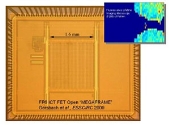Nov 30 2010
The European consortium consisting of TU Delft, the University of Edinburgh, ST Microelectronics, and the National Physical Laboratory (NPL) is aiding in the application and development of a new ultrafast camera. The Megaframe Imager captures images at a speed of one million frames.
 Megaframe Imager
Megaframe Imager
High speeds of image capture have resulted in various applications including high-sensitivity astronomical observations; automotive collision studies; DNA / protein microarray scanning; biochemical sensors; neural imaging; and cellular / sub-cellular imaging. The ultrafast camera utilizes custom-made on-chip intelligence, a single photon avalanche diode (SPAD) device that is highly sensitive. The imager has demonstrated that device could be a powerful technology in the field of biosensing.
According to the Optical Society of America's Biomedical Optics Express journal, the researchers used fluoresence lifetime imaging at low target concentrations with less than 30 sec of acquisition time, and detected viral DNA binding events. DNA microarrays are tools that are vital for biomolecular detection and useful in forensic and mutation analysis, disease screening, and gene expression profiling. In addition, DNA microarrays have a good scope in developing point of care testing systems and personalised drugs.